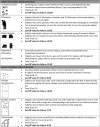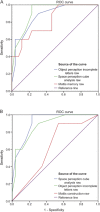Visuoperception test predicts pathologic diagnosis of Alzheimer disease in corticobasal syndrome
- PMID: 24991033
- PMCID: PMC4142003
- DOI: 10.1212/WNL.0000000000000667
Visuoperception test predicts pathologic diagnosis of Alzheimer disease in corticobasal syndrome
Abstract
Objective: To use the Visual Object and Space Perception Battery (VOSP) to distinguish Alzheimer disease (AD) from non-AD pathology in corticobasal syndrome (CBS).
Methods: This clinicopathologic study assessed 36 patients with CBS on the VOSP. All were autopsied. The primary dependent variable was a binary pathologic outcome: patients with CBS who had primary pathologic diagnosis of AD (CBS-AD, n = 10) vs patients with CBS without primary pathologic diagnosis of AD (CBS-nonAD, n = 26). We also determined sensitivity and specificity of individual VOSP subtests.
Results: Patients with CBS-AD had younger onset (54.5 vs 63.6 years, p = 0.001) and lower memory scores on the Mattis Dementia Rating Scale-2 (16 vs 22 points, p = 0.003). Failure on the VOSP subtests Incomplete Letters (odds ratio [OR] 11.5, p = 0.006), Position Discrimination (OR 10.86, p = 0.008), Number Location (OR 12.27, p = 0.026), and Cube Analysis (OR 45.71 p = 0.0001) had significantly greater odds of CBS-AD than CBS-nonAD. These associations remained when adjusting for total Mattis Dementia Rating score, disease laterality, education, age, and sex. Receiver operating characteristic curves demonstrated significant accuracy for Incomplete Letters and all VOSP spatial subtests, with Cube Analysis performing best (area under the curve 0.91, p = 0.0004).
Conclusions: In patients with CBS, failure on specific VOSP subtests is associated with greater odds of having underlying AD. There may be preferential involvement of the dorsal stream in CBS-AD.
Classification of evidence: This study provides Class II evidence that some subtests of the VOSP accurately distinguish patients with CBS-AD from those without AD pathology (e.g., Cube Analysis sensitivity 100%, specificity 77%).
© 2014 American Academy of Neurology.
Figures


Similar articles
-
Visuospatial function in early Alzheimer's disease--the use of the Visual Object and Space Perception (VOSP) battery.PLoS One. 2013 Jul 16;8(7):e68398. doi: 10.1371/journal.pone.0068398. Print 2013. PLoS One. 2013. PMID: 23874610 Free PMC article.
-
Imaging correlates of pathology in corticobasal syndrome.Neurology. 2010 Nov 23;75(21):1879-87. doi: 10.1212/WNL.0b013e3181feb2e8. Neurology. 2010. PMID: 21098403 Free PMC article.
-
Anatomical differences between CBS-corticobasal degeneration and CBS-Alzheimer's disease.Mov Disord. 2010 Jul 15;25(9):1246-52. doi: 10.1002/mds.23062. Mov Disord. 2010. PMID: 20629131 Free PMC article.
-
The many faces of corticobasal degeneration.Parkinsonism Relat Disord. 2007;13 Suppl 3:S336-40. doi: 10.1016/S1353-8020(08)70027-0. Parkinsonism Relat Disord. 2007. PMID: 18267261 Review.
-
The corticobasal syndrome-Alzheimer's disease conundrum.Expert Rev Neurother. 2011 Nov;11(11):1569-78. doi: 10.1586/ern.11.153. Expert Rev Neurother. 2011. PMID: 22014136 Free PMC article. Review.
Cited by
-
Clinicopathologic subtype of Alzheimer's disease presenting as corticobasal syndrome.Alzheimers Dement. 2019 Sep;15(9):1218-1228. doi: 10.1016/j.jalz.2019.04.011. Epub 2019 Aug 6. Alzheimers Dement. 2019. PMID: 31399334 Free PMC article.
-
Relationships between hypometabolism and both β-amyloid and tau PET in corticobasal syndrome.Alzheimers Dement. 2025 Mar;21(3):e70018. doi: 10.1002/alz.70018. Alzheimers Dement. 2025. PMID: 40108988 Free PMC article.
-
Atypical clinical variants of Alzheimer's disease: are they really atypical?Front Neurosci. 2024 Feb 28;18:1352822. doi: 10.3389/fnins.2024.1352822. eCollection 2024. Front Neurosci. 2024. PMID: 38482142 Free PMC article.
-
Clinical Spectrum of Tauopathies.Front Neurol. 2022 Jul 14;13:944806. doi: 10.3389/fneur.2022.944806. eCollection 2022. Front Neurol. 2022. PMID: 35911892 Free PMC article. Review.
-
Latent atrophy factors related to phenotypical variants of posterior cortical atrophy.Neurology. 2020 Sep 22;95(12):e1672-e1685. doi: 10.1212/WNL.0000000000010362. Epub 2020 Jul 16. Neurology. 2020. PMID: 32675078 Free PMC article.
References
-
- Kertesz A, Martinez-Lage P, Davidson W, Munoz DG. The corticobasal degeneration syndrome overlaps progressive aphasia and frontotemporal dementia. Neurology 2000;55:1368–1375 - PubMed
-
- Boeve BF, Lang AE, Litvan I. Corticobasal degeneration and its relationship to progressive supranuclear palsy and frontotemporal dementia. Ann Neurol 2003;54(suppl 5):S15–S19 - PubMed
-
- Mathew R, Bak TH, Hodges JR. Diagnostic criteria for corticobasal syndrome: a comparative study. J Neurol Neurosurg Psychiatry 2012;83:405–410 - PubMed
Publication types
MeSH terms
Grants and funding
LinkOut - more resources
Full Text Sources
Other Literature Sources
Medical
Research Materials
